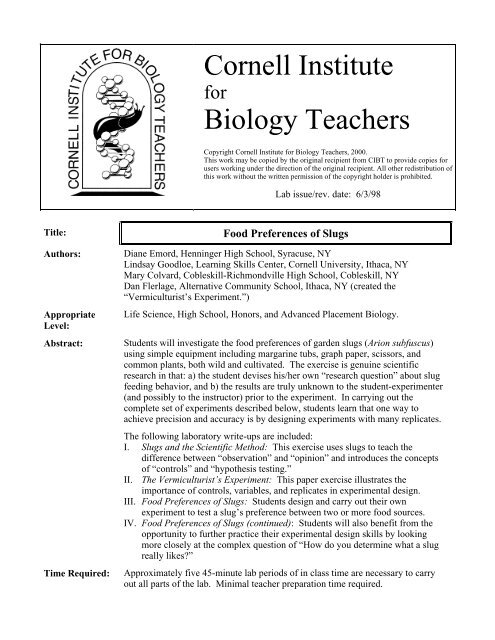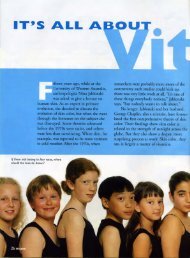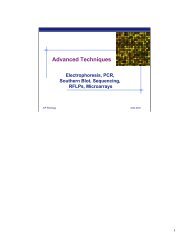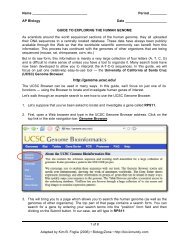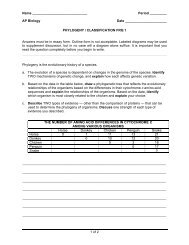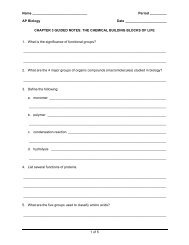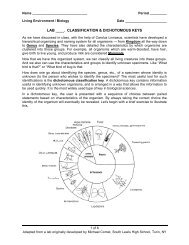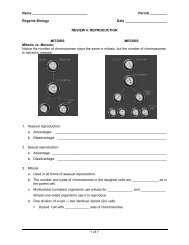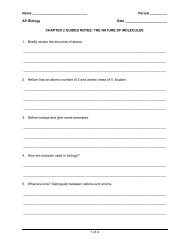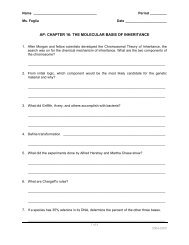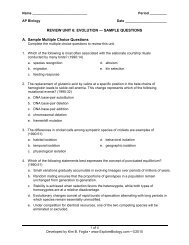Food Preferences of Slugs - Explore Biology
Food Preferences of Slugs - Explore Biology
Food Preferences of Slugs - Explore Biology
Create successful ePaper yourself
Turn your PDF publications into a flip-book with our unique Google optimized e-Paper software.
Cornell Institutefor<strong>Biology</strong> TeachersCopyright Cornell Institute for <strong>Biology</strong> Teachers, 2000.This work may be copied by the original recipient from CIBT to provide copies forusers working under the direction <strong>of</strong> the original recipient. All other redistribution <strong>of</strong>this work without the written permission <strong>of</strong> the copyright holder is prohibited.Lab issue/rev. date: 6/3/98Title:Authors:AppropriateLevel:Abstract:Time Required:<strong>Food</strong> <strong>Preferences</strong> <strong>of</strong> <strong>Slugs</strong>Diane Emord, Henninger High School, Syracuse, NYLindsay Goodloe, Learning Skills Center, Cornell University, Ithaca, NYMary Colvard, Cobleskill-Richmondville High School, Cobleskill, NYDan Flerlage, Alternative Community School, Ithaca, NY (created the“Vermiculturist’s Experiment.”)Life Science, High School, Honors, and Advanced Placement <strong>Biology</strong>.Students will investigate the food preferences <strong>of</strong> garden slugs (Arion subfuscus)using simple equipment including margarine tubs, graph paper, scissors, andcommon plants, both wild and cultivated. The exercise is genuine scientificresearch in that: a) the student devises his/her own “research question” about slugfeeding behavior, and b) the results are truly unknown to the student-experimenter(and possibly to the instructor) prior to the experiment. In carrying out thecomplete set <strong>of</strong> experiments described below, students learn that one way toachieve precision and accuracy is by designing experiments with many replicates.The following laboratory write-ups are included:I. <strong>Slugs</strong> and the Scientific Method: This exercise uses slugs to teach thedifference between “observation” and “opinion” and introduces the concepts<strong>of</strong> “controls” and “hypothesis testing.”II. The Vermiculturist’s Experiment: This paper exercise illustrates theimportance <strong>of</strong> controls, variables, and replicates in experimental design.III. <strong>Food</strong> <strong>Preferences</strong> <strong>of</strong> <strong>Slugs</strong>: Students design and carry out their ownexperiment to test a slug’s preference between two or more food sources.IV. <strong>Food</strong> <strong>Preferences</strong> <strong>of</strong> <strong>Slugs</strong> (continued): Students will also benefit from theopportunity to further practice their experimental design skills by lookingmore closely at the complex question <strong>of</strong> “How do you determine what a slugreally likes?”Approximately five 45-minute lab periods <strong>of</strong> in class time are necessary to carryout all parts <strong>of</strong> the lab. Minimal teacher preparation time required.
• A “slugararium” (a slug-filled aquarium with a lid) is an excellent way to display the animals beforebeginning the lab. If possible, set the slugararium up several days before the lab activity to heightenstudent interest in the slugs.• The instructor’s preparation time might be as little as 15 minutes per class, if students are enlisted tocollect plants and slugs, to obtain empty margarine tubs (with lids), and to punch air holes in thelids. At least one hour <strong>of</strong> preparation time will be required, if the instructor assumes totalresponsibility for these tasks, including slicing fruits and vegetables into comparably thin sections,• <strong>Slugs</strong> can be kept in the refrigerator for several weeks prior to doing the lab and while accumulatingenough <strong>of</strong> them to supply each lab group. Air holes must be made in the lid <strong>of</strong> the container if noneexist. The bottom <strong>of</strong> the container should be partially covered with water (~1mm) to provide amoist environment. Scraps <strong>of</strong> lettuce make satisfactory food. Be sure to set the slugs out <strong>of</strong> therefrigerator at least 24 hours before beginning the experiment.• Plant material <strong>of</strong> various kinds can either be gathered from the yard and garden or purchased at thegrocery store. The possibilities for food plants to use in this exercise are virtually endless. Sinceslugs are <strong>of</strong>ten found in gardens and lawns, they might be provided with a selection <strong>of</strong> plant speciesfound in these areas. Leafy vegetables (lettuce, cabbage, spinach, etc.) can be cut easily into 20 mmx 20 mm squares, as can thinly sliced pieces <strong>of</strong> carrot, turnip, and onion scale leaves. Both grassesand broad-leaved weeds (dandelion, plantain, ground ivy, etc.) are also good choices for food,though some (such as grasses) may be rejected completely. A difficulty with grasses and someother plants is the small size or narrowness <strong>of</strong> the leaves. In such cases, students can cut two ormore pieces <strong>of</strong> leaf (rectangles or smaller squares) to equal a single standard-sized piece. But ifsmaller pieces are used, the instructor should point out that all other foods <strong>of</strong>fered to the slug(s) inthe same experiment should be cut up in the same way to insure that the shape and size <strong>of</strong> the foodplant samples are not uncontrolled variables.• <strong>Slugs</strong> will also feed on filter paper squares which have been soaked in plant extracts for a fewminutes. If students are investigating the basis <strong>of</strong> a food preference, this procedure would allowthem to eliminate texture as a variable. The filter paper may also be soaked in food coloring (e.g.,red versus green), or seasonings (e.g., a sugar solution, monosodium glutamate (MSG), mustard,vinegar). Of course, in any experiment involving filter paper squares, a piece soaked only in watershould be placed in the feeding chamber as a control, but the instructor may wish to let his studentscome up with that idea.• One potential problem is keeping track <strong>of</strong> which pieces are which since marks made on the samplemay be eaten by the slugs. The best approach is to indicate the positions <strong>of</strong> the different squares byusing appropriately labeled pieces <strong>of</strong> masking tape affixed to the outside <strong>of</strong> the feeding tub at thepoint nearest to the position <strong>of</strong> the corresponding square inside. Even this technique may fail if theslugs move the squares from their original positions. Though unlikely to occur, this may necessitatesmelling the remains in order to establish positive identification!©2000 CIBT <strong>Food</strong> <strong>Preferences</strong> <strong>of</strong> <strong>Slugs</strong> – Teachers Section Page 4
8. Do individual slugs seek a “balanced diet” by periodically changing from one food preferenceto another?9. Does hairiness or fuzziness <strong>of</strong> leaves influence food choice?10. Are young leaves, or other plant parts, preferred to old?11. Are moist, fresh leaves preferred to dry ones?12. Does temperature (or light or sound) influence food consumption?13. For a cultivated plant <strong>of</strong> which only one part is eaten by humans (e.g. tomatoes, carrots), doslugs prefer the same part as humans?14. Do any plants (e.g. marigolds) suppress feeding behavior?15. As a class, are non-green parts <strong>of</strong> plants (flowers, fruits, roots) preferred to green parts?16. Will slugs eat mushrooms? Do they prefer them to green plants? Do slugs distinguish betweenpoisonous and non-poisonous mushrooms (or poisonous and non-poisonous green plants)?17. What is the effect <strong>of</strong> “food additives” (e.g., sugar, vinegar, MSG, pepper) on food choice?18. Do different species <strong>of</strong> slugs exhibit the same food preferences?19. Does a dry environment (or any other environmental variable) affect feeding behavior?• It is important for students to snap the lid <strong>of</strong> the tub on tightly after putting in the slug. <strong>Slugs</strong> areremarkably adept at squeezing through very narrow openings!• The method suggested for determining the amount <strong>of</strong> food eaten by the slugs is to measure the areaconsumed, estimated with the aid <strong>of</strong> graph paper. Since the slug’s food is <strong>of</strong>ten wet and it causesthe graph paper to become wet, it works well if you can copy the graph grid onto an acetate sheet.The plastic is transparent and easy to mark on and doesn’t fall apart when wet. It is important to usegraph paper with 1 mm rulings to insure reasonably accurate estimates. Area consumption waschosen over mass consumption as the means <strong>of</strong> estimating food intake because a) satisfactorybalances may not be readily available, and b) mass change estimates are probably less reliable thanarea change estimates because <strong>of</strong> osmotic uptake <strong>of</strong> water by plant tissue. The accuracy <strong>of</strong> areachange estimates as a measure <strong>of</strong> consumption is, <strong>of</strong> course, completely dependent on theassumption that all squares <strong>of</strong> food are <strong>of</strong> equal thickness. When the food consists <strong>of</strong> thin leaves,this assumption is probably safe, but it could be drastically in error if thicker leaves or slices <strong>of</strong>carrot, etc. are used. If plant materials requiring slicing are to be among the food choices, it may bebest for the instructor to prepare the slices before class, using a razor blade or sharp knife.• One <strong>of</strong> the most important results <strong>of</strong> this exercise is that students will be exposed to the variability<strong>of</strong> biological data. It is very possible that not all slugs will show the same feeding preferences, andthey all will certainly not consume the same amount <strong>of</strong> food. A. P. classes might be introduced tostatistical procedures such as the Chi-square, t-test, or Mann-Whitney U test, which are used toanalyze and interpret variation in quantitative data. In any case, after performing and discussing theresults <strong>of</strong> the experiments, all students should have gained an increased awareness <strong>of</strong> the importance<strong>of</strong> collecting quantitative data and <strong>of</strong> performing several replications <strong>of</strong> an experiment in order todraw reliable conclusions.©2000 CIBT <strong>Food</strong> <strong>Preferences</strong> <strong>of</strong> <strong>Slugs</strong> – Teachers Section Page 6
Answers to QuestionsPre-lab reading:1. The slug is an example <strong>of</strong> an “introduced species” that has become a pest. Can you think <strong>of</strong> otherintroduced species that have become pests?The Gypsy moth, Mediterranean fruit fly, and Japanese beetle are examples <strong>of</strong> introduced insectpest species; starlings and house sparrows are examples <strong>of</strong> exotic bird species.2. What reasons can you suggest for the fact that introduced species tend to be ecologically and/oreconomically destructive?The usual explanation for rapid population increase <strong>of</strong> an exotic species is that in its newenvironment it has escaped natural population control mechanisms, which include parasitism(disease), predation, and competition.The Vermiculturist’s Experiment:• Trial 3 Conclusions:The variable is the % sand. There is no real difference in the rate <strong>of</strong> reproduction when % sand isdecreased from 15% to 10%. The number <strong>of</strong> egg cases decreases by 2.• Trial 4 Conclusions:The variable is the amount <strong>of</strong> food supplied. There appears to be a modest increase in the rate <strong>of</strong>reproduction when the food is increased from 10 - 15 grams per square foot.• Trial 5 Conclusions:The variable is the % moisture in the soil. There is no difference in the rate <strong>of</strong> reproduction whensoil moisture is varied between 20% and 25%.• Trial 6 Conclusions:The variable is whether the soil is covered. Covering the soil leads to a significant increase in therate <strong>of</strong> reproduction.• How did the vermiculturist ensure that they had replicates? Was each trial able to be repeated?What are some assumptions the vermiculturist had to make?The conditions under which the experiment was conducted (% moisture in the soil, amount <strong>of</strong> foodgiven per square foot, etc.) were carefully recorded and monitored. It was possible to repeat theexperiment many times under the same conditions because <strong>of</strong> the detailed record keeping done bythe vermiculturist. Each trial was repeated every 24 hours for one month. Thus each trial hadapproximately 30 replicates. Some assumptions made might be: a. that the worms would continueto produce eggs after their initial production <strong>of</strong> cases; b. that the worms would not be killed by thechanges made in their environment.©2000 CIBT <strong>Food</strong> <strong>Preferences</strong> <strong>of</strong> <strong>Slugs</strong> – Teachers Section Page 7
Annotated References• Barnes, Robert D. Invertebrate Zoology, 5th ed. W. B. Saunders Company, Philadelphia, 1987.An authoritative general guide to the biology <strong>of</strong> all invertebrate groups, including the Mollusca. Itincludes interesting technical information about all aspects <strong>of</strong> the gastropods: evolution, ecology,anatomy, and physiology.• Brown, Luther, and Jerry F. Downhower. Analyses in Behavioral Ecology. Sinauer Associates,Inc., Sunderland, Massachusetts, 1988.Useful for its clear descriptions (with examples) <strong>of</strong> many statistical tests used in studies <strong>of</strong> animalbehavior• Burch, John B. How To Know The Eastern Land Snails. Wm. C. Brown Company, Dubuque,Iowa, 1962.Indispensable for species identification <strong>of</strong> slugs and snails, and a good source <strong>of</strong> information aboutthe general biology and ecology <strong>of</strong> terrestrial gastropods.• Fernald, Merritt Lyndon. Gray’s Manual <strong>of</strong> Botany, a Handbook <strong>of</strong> the Flowering Plants andFerns <strong>of</strong> the Central and Northeastern United States and Adjacent Canada. Van NostrandCompany, New York, 1970.Notes the origin (native or introduced) <strong>of</strong> nearly every plant found in the northeastern U.S.• Gill, John and Pauline Howell. “<strong>Food</strong> choice in the common snail (Helix aspersa),” Journal <strong>of</strong>Biological Education 19 (1): 6-7, 1985.The source <strong>of</strong> both the general concept and most <strong>of</strong> the specific procedures <strong>of</strong> this laboratoryexercise.• Raven, Peter H., Ray F. Evert, and Susan E. Eichhorn. <strong>Biology</strong> <strong>of</strong> Plants, 5th ed. Worth Publishers,Inc., New York, 1992.An accessible reference describing the process <strong>of</strong> plant-- herbivore coevolution, with someinteresting examples <strong>of</strong> plant chemical defenses.©2000 CIBT <strong>Food</strong> <strong>Preferences</strong> <strong>of</strong> <strong>Slugs</strong> – Teachers Section Page 8
Graph Paper© 2000 CIBT <strong>Food</strong> <strong>Preferences</strong> <strong>of</strong> <strong>Slugs</strong> – Teachers Section Page 9
The <strong>Biology</strong> and Natural History<strong>of</strong> the Common Garden SlugThis passage should be read before doing the experiment entitled <strong>Food</strong> <strong>Preferences</strong> Of<strong>Slugs</strong>.<strong>Slugs</strong> are generally from 1 to 2 inches long. They may be gray, black, white, amber,yellow, brown, spotted, or blotched with irregular black areas. The foot is usuallyyellowish and produces a copious amount <strong>of</strong> milky mucus. The head has 2 pairs <strong>of</strong> feelers,the longer pair with eyes at the tips.<strong>Slugs</strong> are mollusks and along with snails are classified as gastropods. The name‘‘gastropod’’ (‘‘stomach-foot”) refers to the fact that snails and slugs appear to crawl on theirbellies. Like other gastropods, slugs have the standard molluskan body plan whichincludes:• a ventral muscular foot used for locomotion.• a dorsal mantle which in most mollusks secretes the shell.• a visceral mass which contains the internal organs (viscera) such as the digestiveand reproductive organs, and is located between the foot and the mantle.• a radula which is a ribbon-like feeding structure containing many tiny teethwhich the slug protrudes through its mouth and uses to rasp <strong>of</strong>f particles <strong>of</strong> food.©2000 CIBT <strong>Food</strong> <strong>Preferences</strong> <strong>of</strong> <strong>Slugs</strong> – Supplemental Reading Section Page 1
Although the majority <strong>of</strong> the 40,000 species <strong>of</strong> gastropods live in the oceans or in freshwater, many species have evolved adaptations enabling them to live successfully on land.One <strong>of</strong> the most important <strong>of</strong> these is the evolution <strong>of</strong> a lung for breathing air.Anatomically, the lung is formed from the mantle cavity - the space between the bottom <strong>of</strong>the mantle and the top <strong>of</strong> the visceral mass. Air enters and leaves the lung through abreathing pore visible at the lower edge <strong>of</strong> the mantle on the right side. Its preciselocation is a feature used to help identify the different kinds <strong>of</strong> slugs.In at least one respect, snails and slugs do not seem to be as well adapted to life on land asinsects and the terrestrial vertebrates. Whereas these groups have a waterpro<strong>of</strong>exoskeleton or skin, the land-dwelling snails and slugs have a water-permeable skin. As aresult, they are vulnerable to dehydration (drying out) and death when confronted withhot, dry environmental conditions. At such times, snails can retreat into their shells, butslugs don’t have that option. Instead, they have two other strategies for survival. First,they can survive a water loss equal to 80% <strong>of</strong> their body weight. (A human being, incontrast, can only tolerate a 12% water loss.) Second, they avoid potentially stressfulsituations by hiding under leaf litter, logs, rocks, etc. during the heat <strong>of</strong> the day. Theyemerge to feed when conditions are cooler and damper, particularly at night or following arain.<strong>Slugs</strong> are hermaphrodites with reciprocal mating. Each slug produces from 500 to 800eggs. Each egg is from 1/16 to 1/8th inch long, whitish, and laid in moist soil among plantroots. The eggs are usually deposited in groups <strong>of</strong> 50 and hatch in 3 weeks (or overwinter). Adult slugs that survive the winter may lay eggs in May. By October, the newlyhatched eggs should have developed into slugs sufficiently mature to mate and lay eggs.The slug was introduced into the U.S. from Europe, during the early part <strong>of</strong> the lastcentury. It first appeared in port cities such as Boston, New York, and Philadelphia. It isnow widely distributed over the eastern U.S. The common species <strong>of</strong> slugs found in thisregion are generally herbivores, feeding on a variety <strong>of</strong> plants. Because many <strong>of</strong> theseplants are cultivated fruits, vegetables, and ornamentals, some kinds <strong>of</strong> slugs areconsidered pests. When present in high numbers, they can be very destructive in gardensand greenhouses.1. The slug is an example <strong>of</strong> an ‘‘introduced species’’ that has become a pest. Can youthink <strong>of</strong> other introduced species that have become pests?2. What reasons can you suggest for the fact that introduced species tend to beecologically and/or economically destructive?©2000 CIBT <strong>Food</strong> <strong>Preferences</strong> <strong>of</strong> <strong>Slugs</strong> – Supplemental Reading Section Page 2
<strong>Slugs</strong> and the Scientific MethodCIBTStudentLaboratoryExerciseObjectivesIn this lab you will:• make observations <strong>of</strong> slug behavior.• accurately record observations.• understand the difference between an observation and an inference or an opinion.• discuss findings with other class members.IntroductionThere are certain basic skills necessary for successfully carrying out any scientificinvestigation, be it the analysis <strong>of</strong> enzyme activity or the dissection <strong>of</strong> a worm. One <strong>of</strong>these skills is the ability to observe carefully and accurately. You will come across theword ‘‘observe’’ many times in your labs. Scientific observation is very different fromobserving a film or television show. First <strong>of</strong> all, observing is not limited to seeing. All <strong>of</strong>your senses may be used, and your senses may be extended with equipment such asmicroscopes. Therefore, odors, textures, tastes (but don’t do it in lab), sounds,measurements <strong>of</strong> length, volume and mass are all considered observations and are thebasis <strong>of</strong> data collection in lab. Ask yourself questions about the reasons for and thesignificance <strong>of</strong> what you observe. Record your observations carefully and accurately. Yourconclusions will be based on your observations, so try not to fall into the trap <strong>of</strong> moldingyour observations to fit a preconceived notion <strong>of</strong> a ‘‘right answer.’’Scientists must be aware <strong>of</strong> the distinction between true observations, inferences, andinterpretations <strong>of</strong> observations and opinions. Carefully consider the following definitionswhen recording information as a part <strong>of</strong> an investigation.• Observations: Data collected with any <strong>of</strong> the senses or tools such as thermometers,graduated cylinders, balances or rulers.• Inferences: Conclusions or deductions based on observations; they may be verysubtle and you may at first be unaware you are making them.• Opinions: Everyone has them and everyone’s opinion should be respected, but theyshould be left out <strong>of</strong> our data collection and analysis.©2000 CIBT <strong>Slugs</strong> and the Scientific Method – Student Section Page 1
Materials• Slug • metric ruler• plastic container with lid to serve as “slughome”• hand lens• slug food such as lettuce or other leaves • dissecting microscope (optional)• large petri dish to place slug into while makingobservationsSafety Precautions• Good laboratory practice should be followed at all times during this laboratory.• Treat the slug humanely. It is a living organism!• Never consume laboratory specimens!Procedure1. Obtain a slug in a plastic container with a lid.2. Make 12 observations <strong>of</strong> your slug - these may be anything about the slug’s physicalappearance or behavior - anything you can observe. Write these observations in thedata chart on the next page.3. When finished, exchange your data table with your partner and evaluate each others’observations; state whether each observation is really an observation, an inference, oran opinion.Analysis1. Take any 2 <strong>of</strong> your observations and intentionally make inferences about them.Express each <strong>of</strong> these inferences in a complete sentence.2. Again using a complete sentence, state an opinion about slugs.©2000 CIBT <strong>Slugs</strong> and the Scientific Method – Student Section Page 2
Slug Observation Data TableObserver: ___________________Record your observations below.Evaluator: _______________Indicate the type <strong>of</strong> statement1.2.3.4.5.6.7.8.9.10.11.12.©2000 CIBT <strong>Slugs</strong> and the Scientific Method – Student Section Page 3
The Vermiculturist’s ExperimentCIBTStudentLaboratoryExerciseObjectivesIn this part <strong>of</strong> the lab you will:• examine an experiment for the integrity <strong>of</strong> its design.• recognize when an experiment has a valid control.• be able to explain the importance <strong>of</strong> replicates.• analyze and interpret data.IntroductionSeveral <strong>of</strong> the labs we will do this year will require you to design an experiment that willprovide the answers to scientific questions. In designing your experiment, it is importantthat you understand the use <strong>of</strong> ‘‘controls.’’A control is an established reference point. It allows you to make comparisons thatgenerate valid information. The key to the use <strong>of</strong> a control is to be sure that, in anyexperiment, only one variable is changed relative to the control.In this exercise you will be provided with data collected from a series <strong>of</strong> experimentsdesigned to identify factors that optimize the production <strong>of</strong> earthworms. You will analyzethe results <strong>of</strong> these experiments to learn the importance <strong>of</strong> controls, variables, andreplicates.Materials• no special materials other than this lab write-up.©2000 CIBT The Vermiculturist’s Experiment – Student Section Page 1
ProceduresA person involved with ‘‘vermiculture’’ (the raising <strong>of</strong> worms) is trying to determine theoptimal (best) conditions for maximizing the reproductive rate <strong>of</strong> worms (the # <strong>of</strong> egg caseslaid/24 hour time period). This person has identified the following variables that theywould like to investigate:• % moisture content <strong>of</strong> soil by weight• whether the soil is covered or not• % sand in soil by weight• % sand in soil by volume• the amount <strong>of</strong> food (cornmeal) spread on each square foot <strong>of</strong> soil.Below is a chart <strong>of</strong> the conditions used for the past month with the averaged results (# <strong>of</strong>egg cases/24 hours).Trial #% Moisture insoil (weight)% Sandin soil(Volume)Soil Covered(Yes/No)Amount <strong>of</strong>food given persquare ft.RESULTS# egg cases(in 24 hrs)1 20% 15% No 10 grams 54The vermiculturist decided to determine the effect <strong>of</strong> changing the variables. Thefollowing trial was tried for a period <strong>of</strong> one week and the results were once againaveraged.Trial #% Moisture insoil (weight)% Sandin soil(Volume)Soil Covered(Yes/No)Amount <strong>of</strong>food given persquare ft.RESULTS# egg cases(in 24 hrs)2 25% 10% Yes 15 grams 92Look closely at the two trials. In your opinion, what caused the large increase in thenumber <strong>of</strong> egg cases laid in a 24 hour period? On separate paper, explain how you arrivedat this conclusion.After looking at the set-up and the results <strong>of</strong> the two trials, the vermiculturist realizedthat it was impossible to be sure <strong>of</strong> what actually caused the huge increase in eggproduction because there are too many variables in this experiment. So, the tireless worm©2000 CIBT The Vermiculturist’s Experiment – Student Section Page 2
farmer decided to try a number <strong>of</strong> additional trials in order to determine which variableshad what effect. The results <strong>of</strong> these trials along with the data from the original trial aregiven below.For each trial, using Trial #1 as the ‘‘control,’’ write a conclusion stating what thevermiculturist could learn from his or her efforts.Trial #% Moisture insoil (weight)% Sandin soil(Volume)Soil Covered(Yes/No)Amount <strong>of</strong>food given persquare ft.RESULTS# egg cases(in 24 hrs)3 20% 10% No 10 grams 52Record your conclusion for Trial #3 on your own paper. Explain how you arrived at thisconclusion.Trial #% Moisture insoil (weight)% Sandin soil(Volume)Soil Covered(Yes/No)Amount <strong>of</strong>food given persquare ft.RESULTS# egg cases(in 24 hrs)4 20% 15% No 15 grams 64Record your conclusion and reasoning for Trial #4.Trial #% Moisture insoil (weight)% Sandin soil(Volume)Soil Covered(Yes/No)Amount <strong>of</strong>food given persquare ft.RESULTS# egg cases(in 24 hrs)5 25% 15% No 10 grams 53Record your conclusion for Trial #5 along with an explanation <strong>of</strong> how you came to thisconclusion.Trial #% Moisture insoil (weight)% Sandin soil(Volume)Soil Covered(Yes/No)Amount <strong>of</strong>food given persquare ft.RESULTS# egg cases(in 24 hrs)6 20% 15% Yes 10 grams 82©2000 CIBT The Vermiculturist’s Experiment – Student Section Page 3
Record your conclusion for Trial #6 along with an explanation <strong>of</strong> how you came to thisconclusion.The important thing about the set-up is that for each comparison, only one variable at atime is actually different. This makes it quite easy to determine the effect <strong>of</strong> that specificvariable by always comparing it to the control. So far, we know that a good experimentmust:• have a control• test only one variable at a timeIn addition, a good experiment must have replicates, be able to be repeated, and have aminimum number <strong>of</strong> assumptions. Write a paragraph that uses information from theexperiment to explain how the vermiculturist took care <strong>of</strong> the above three requirements.Record your answer on the same sheet <strong>of</strong> paper you used to explain how you arrived atyour conclusions for each <strong>of</strong> the trials. Be sure to use complete sentences for all <strong>of</strong>your answers.©2000 CIBT The Vermiculturist’s Experiment – Student Section Page 4
<strong>Food</strong> <strong>Preferences</strong> Of <strong>Slugs</strong>CIBTStudentLaboratoryExerciseObjectivesIn this lab you will:• design and carry out a biological experiment.• make observations <strong>of</strong> slug feeding behavior.• accurately record observations and organize data.• draw conclusions and make deductions based on data.• discuss findings with other class members.IntroductionIn this lab you will design an experiment, collect data, and analyze your results to test thefeeding preferences <strong>of</strong> the common garden slug, Arion subfuscus.Materials• slug • hand lens• plastic container to serve as ‘‘slug home’’ • metric ruler• slug food such as lettuce or other leaves • scissors• graph grids transferred to transparencyfilm• dissecting microscope (optional)Safety Precautions• Good laboratory practice should be followed at all times during this laboratory.• Treat the slug humanely. It is a living organism!• Never consume laboratory specimens.• Be careful when using scissors.©2000 CIBT <strong>Food</strong> <strong>Preferences</strong> <strong>of</strong> <strong>Slugs</strong> – Student Section Page 1
ProcedureIn this lab, you will be asked to consider the feeding behavior <strong>of</strong> slugs and to also think <strong>of</strong>a question that you will then attempt to answer by measuring the quantity <strong>of</strong> foodconsumed by one or more slugs. While the example <strong>of</strong> the worms and the vermiculturisthas nothing to do with the problem you will be facing in your lab this week, the process issimilar. What are five characteristics <strong>of</strong> a good experiment? (Record your answer below.)1.2.3.4.5.Your experimental design should include each <strong>of</strong> the five characteristics you listed. Youshould also think about how you will collect your data and how you will analyze the data.1. Formulate a question about the feeding behavior <strong>of</strong> slugs. For example, you mightask, ‘‘Do slugs have a color preference in the foods they eat?’’ Make sure your questionis testable with the materials and the amount <strong>of</strong> time available. On a separate piece<strong>of</strong> paper, and using complete sentences, write down the following:a. State the hypothesis.b. Identify the controls.c. Identify the variable(s).d. How will the data be collected?e. How many replicates will there be?f. List three assumptions.g. Check with your instructor to be sure your question and approach will beappropriate.2. Decide what two food materials are necessary for your experiment and get them.3. Cut a 20 mm x 20 mm square <strong>of</strong> graph grid.4. Put the square on the leaf. Carefully cut around the square with scissors. Repeat thisprocedure until you have obtained two 20 mm x 20 mm squares <strong>of</strong> each <strong>of</strong> the twotypes <strong>of</strong> food you are testing. (If the leaf is too small or narrow to cut squares <strong>of</strong> thissize, cut 20 mm x 10 mm rectangles or other shapes as directed by your instructor.Regardless <strong>of</strong> the size and shape <strong>of</strong> the pieces, it is important that all items <strong>of</strong> foodhave the same size and shape, and be added to the feeding container in the same totalquantity.)©2000CIBT <strong>Food</strong> <strong>Preferences</strong> <strong>of</strong> <strong>Slugs</strong>– Student Section Page 2
5. Examine the thickness <strong>of</strong> the squares. Since it is important that the volume <strong>of</strong> all thepieces be approximately the same, use a razor blade to cut any unusually thicksquares down to a uniform size, or ask the instructor to do so.6. Place the leaf squares on the bottom <strong>of</strong> the feeding container provided. Figure out agood and water-pro<strong>of</strong> system for labeling your containers and squares.7. Add 1 ml (about a quarter <strong>of</strong> a teaspoonful) <strong>of</strong> water to the container.8. Deposit a slug in the container with the food and securely place the lid on thecontainer. Be sure that the lid has numerous small air holes in it!9. Label your container(s) and place them in the area <strong>of</strong> the room designated by yourinstructor.10. Examine the container after 24 hours and count the number <strong>of</strong> small squaresconsumed for each food sample. Calculate the percentage <strong>of</strong> food consumed for eachsample. To do this divide the number <strong>of</strong> squares consumed by the total number <strong>of</strong>squares <strong>of</strong> the food sample. (For example, if a slug ate 15 small squares <strong>of</strong> food #1 and7 small squares <strong>of</strong> sample #2, then for Sample #1, 15/25 = 0.6, which is 60%. Forsample #2, 7/25 = 0.28, or 28%.)11. Record your results on the following page.12. Clean out your slug container as directed by your teacher.©2000CIBT <strong>Food</strong> <strong>Preferences</strong> <strong>of</strong> <strong>Slugs</strong>– Student Section Page 3
DataType <strong>of</strong> foods tested:<strong>Food</strong> #1: __________________________________<strong>Food</strong> #2: __________________________________<strong>Food</strong> #1: ___________________Amount(# <strong>of</strong> squares)<strong>of</strong> <strong>Food</strong> #1sample 1 eaten(a) = _________ squareseaten<strong>Food</strong> #2: _____________________Amount(# <strong>of</strong> squares)<strong>of</strong> <strong>Food</strong> #2sample 1 eaten(a) = _________ squareseaten% <strong>of</strong> <strong>Food</strong> #1sample 1 eaten(% = number <strong>of</strong>squares eaten/total squaresavailable)(b) = _________ % sampleeaten% <strong>of</strong> <strong>Food</strong> #2sample 2 eaten(% = number <strong>of</strong>squares eaten/total squaresavailable)(b) = _________ % sampleeatenAmount(# <strong>of</strong> squares)<strong>of</strong> <strong>Food</strong> #1sample 2 eaten(c) = _________ squareseatenAmount(# <strong>of</strong> squares)<strong>of</strong> <strong>Food</strong> #2sample 2 eaten(c) = _________ squareseaten% <strong>of</strong> <strong>Food</strong> #1sample 2 eaten(% = number <strong>of</strong>squares eaten/total squaresavailable)(d) = _________ % sampleeaten% <strong>of</strong> <strong>Food</strong> #2sample 2 eaten(d) = _________ % sampleeatenAverage %eaten <strong>Food</strong> #1note: (b+ d)/2= average_______________ average% eatenAverage %eaten <strong>Food</strong> #2note: (b+ d)/2= average_______________ average% eaten©2000CIBT <strong>Food</strong> <strong>Preferences</strong> <strong>of</strong> <strong>Slugs</strong>– Student Section Page 4
CalculationsShow your calculations for each step on your own paper.AnalysisUsing complete sentences, answer each <strong>of</strong> the following questions on your own paper.1. Make a conclusion based on the results <strong>of</strong> your experiment. Write your conclusion inthe form <strong>of</strong> a hypothesis.2. Does the data support your hypothesis?3. Design at least one other experiment to further test your hypothesis.4. What were some possible sources <strong>of</strong> error in your original experiment?5. How could you improve upon the design <strong>of</strong> your original experiment?©2000CIBT <strong>Food</strong> <strong>Preferences</strong> <strong>of</strong> <strong>Slugs</strong>– Student Section Page 5
<strong>Food</strong> <strong>Preferences</strong> <strong>of</strong> <strong>Slugs</strong>:The Next Chapteror<strong>Slugs</strong> II!!CIBTStudentLaboratoryExerciseObjectivesIn this lab you will:• formulate a hypothesis about slug feeding behavior.• design and carry out a biological experiment to determine if your hypothesis is correct.• make observations <strong>of</strong> slug feeding behavior.• accurately record observations and organize data.• draw conclusions and make deductions based on data.• discuss findings with other class members.IntroductionOne <strong>of</strong> the most exciting things about science is that scientists never run out <strong>of</strong> questions!As a result <strong>of</strong> your last experiment with slugs, you may have discovered some <strong>of</strong> the foodsthat slugs seem to like, and some that they don’t like. But is that the whole story? Ofcourse not! Why do slugs ‘‘like’’ the foods they do and what experiments could you do t<strong>of</strong>ind out? If a slug liked (or disliked) a food when you tested it, does the slug always feelthe same way about that food? Or do certain conditions make the slug ‘‘pickier’’? Whatexperiments could you do to answer these questions? You can probably think <strong>of</strong> manymore questions about slug food preferences and you should have some good ideas abouthow to design experiments to answer these questions.Your task for today’s lab is to think <strong>of</strong> a specific question concerning the feeding behavior<strong>of</strong> slugs, write a hypothesis about slug feeding preference, and then design and carry outan experiment that attempts to test your hypothesis.©2000CIBT <strong>Food</strong> <strong>Preferences</strong> <strong>of</strong> <strong>Slugs</strong> II– Student Section Page 1
Materials• slug • metric ruler• plastic container to serve as slug home • scissors• slug food such as lettuce or other leaves • hand lens• graph grids transferred to transparencyfilm• dissecting microscope (optional)• assorted other materials depending ondesign <strong>of</strong> experimentSafety Precautions• Treat the slug humanely. It is a living organism!• Never consume laboratory specimens.• Be careful when using scissorsProcedure1. Write a question about the feeding behavior <strong>of</strong> slugs. Express your question in theform <strong>of</strong> a hypothesis. Make sure your hypothesis is testable with the materials andamount <strong>of</strong> time available. Check with your teacher to be sure it is appropriate. Haveyour teacher initial here that your question is acceptable to test:_________________initials/date2. Determine what type(s) <strong>of</strong> plant material are necessary for your experiment, andobtain samples <strong>of</strong> each material needed.3. Follow the same basic procedure as in the previous lab, modifying it as necessary totest your hypothesis. You may need to make special modifications depending on whatyour hypothesis states.©2000CIBT <strong>Food</strong> <strong>Preferences</strong> <strong>of</strong> <strong>Slugs</strong> II– Student Section Page 2
4. Upon completion, <strong>of</strong> the experiment, write up your lab using the followingformat:I. State your hypothesis.II.Briefly outline the procedure you followed and how you collected your data.III. Present your data in a neat, organized data table.IV. State a conclusion, if you were able to make one.V. Describe any problems you encountered.VI. List any modifications you would make if you were to repeat this experiment.©2000 CIBT <strong>Food</strong> <strong>Preferences</strong> <strong>of</strong> <strong>Slugs</strong> II – Student Section Page 3


